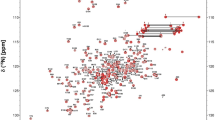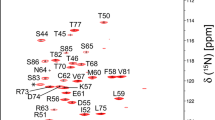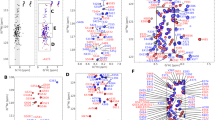Abstract
Most of the translational control of gene expression in higher eukaryotes occurs during the initiation step of protein synthesis. While this process is well characterized in mammalian cells, it is less defined in parasites, including the ones that cause human Leishmaniasis. The Leishmania cap-binding isoform 1 (LeishIF4E-1) is the only isoform that binds the specific trypanosomatids-specific hypermethylated 5′ cap, called cap-4, in the human stage of the parasite life cycle. We report here the extensive NMR resonance assignment of LeishIF4E-1 bound to a cap analog, m7GTP. The chemical shift data constitute a prerequisite to understanding specific translation initiation mechanisms used in Leishmania parasites and to developing antiparasitic drugs targeting their translation initiation factors.
Similar content being viewed by others

Avoid common mistakes on your manuscript.
Biological context
The translation initiation heterotrimeric complex, eIF4F, recruits the 5′ end of mRNAs to the small ribosomal subunit (Shirokikh and Preiss 2018). In human cells, this complex comprises a cap-binding protein, eIF4E, which specifically binds a methylated cap structure (m7GTP) at the 5′ end of most cellular mRNAs. A scaffold protein, eIF4G, binds eIF4E, the DEAD-box RNA helicase eIF4A, the poly-A binding protein PABP, and the multisubunit eIF3, which binds to the small ribosomal subunit. eIF4G interacts with eIF4E through a consensus motif, Y(X)4LΦ (where X is any amino acid and Φ is a hydrophobic residue). Despite our increasing knowledge of translation mechanisms in human cells, how the equivalent process is carried out in trypanosomatids, including Leishmania major, is not as well understood.
The specific factors involved in translation initiation vary depending on the developmental stage of Leishmania parasites. These parasites encode six highly diverged cap-binding protein isoforms (LeishIF4E-1 through −6) that significantly differ among themselves and from their orthologs in mammalian cells (Yoffe et al. 2004, 2006, 2009; Zinoviev et al. 2011). Trypanosomatids also contain a specific hypermethylated cap structure at the 5′ end of their mRNAs, called cap-4 (Reolon et al. 2019; Leiter et al. 2020). In the human developmental stage of the parasite’s life cycle, LeishIF4E-1 is the only isoform that is highly expressed and maintains cap-binding activity, suggesting that it is the functional cap-binding protein in the human infective stage (Zinoviev et al. 2011). LeishIF4E-1 does not, however, interact with any of the predicted LeishIF4G scaffold proteins, suggesting that LeishIF4E-1 is recruited to the LeishIF4F translation initiation complex through novel interactions, or that translation initiation in amastigotes proceeds through a cap-independent mechanism. A crystal structure of LeishIF4E-1 bound to a fragment of a novel IF4E interacting protein (Meleppattu et al. 2018), Leish4E-IP1, showed that the core of LeishIF4E-1 is structurally conserved when compared to eIF4E. Structural analysis, coupled with biochemical assays, revealed that Leish4E-IP1 represses cap-binding. As the cap was absent in the crystal structure, the structure did not allow us to visualize how LeishIF4E-1 interacts with the 5’ mRNA cap. Here, we report the extensive NMR resonance assignment of LeishIF4E-1 bound to a m7GTP cap analog.
Methods and experiments
Constructs
A plasmid that encodes full-length Leishmania IF4E-1 (LeishIF4E-1, accession number: LmjF27.1620, which is 214 amino acids in length, with a molecular weight of 24.2 kDa) that is expressed as a fusion protein with a hexahistidine (His6) tag, and a Tobacco Etch Virus (TEV) protease cleavage site at its N terminus, pHis6-TEV-LeishIF4E-1, has been previously described (Meleppattu et al. 2018). From this plasmid, we used site-specific mutagenesis to generate several tryptophan mutants by polymerase chain reaction (LeishIF4E-1 numbering: W22G, W25G, W37A, W83A, W95G and W133G).
Sample preparation
We grew E. coli strain BL21 (DE3) cells transformed with this plasmid in M9 minimal media containing 95% 2H2O supplemented with 15NH4Cl (1 g/L) and 13C6-D-glucose (2 g/L), when required, as the sole nitrogen and carbon sources, respectively. We used 1 mM of isopropyl β-D-1-thiogalactopyranoside (IPTG) to induce protein expression and grew cells at 20 °C for 16 hours. We harvested and re-suspended cells in buffer containing 50 mM NaH2PO4/Na2HPO4, pH 7.8, 500 mM NaCl, 10 mM imidazole, 5 mM 2-β-mercaptoethanol, benzonase and EDTA-free protease inhibitor cocktail tablet (Roche). We lysed cells by sonication at 4 °C and centrifuged the resulting lysate. We purified the His6-TEV-LeishIF4E-1 protein on a nickel-affinity column (Ni-NTA; Qiagen) as previously described (Meleppattu et al. 2018). We digested the eluted protein with TEV protease to cleave the His6 tag for 12 h (overnight reaction). We concentrated the protein by ultrafiltration using a 10 kDa-cutoff filter (Millipore Sigma). We further purified LeishIF4E-1 from the cleaved tag using a Superdex 75 HiLoad 16/60 preparative size exclusion column (GE Healthcare Life Sciences). After size exclusion purification, we concentrated the protein, added 5 mM of m7GTP (Millipore Sigma) and incubated overnight. We buffer exchanged samples into an NMR buffer (50 mM NaH2PO4/Na2HPO4, pH 6.5, 100 mM NaCl, 2 mM DTT, 5 mM m7GTP 5% D2O, concentrated to 0.1–0.4 mM) and removed excess of m7GTP using a desalting PD-10 column (GE Healthcare). NMR spectroscopy experiments were recorded at 298 K either on Bruker or Varian spectrometers, operating at high field strengths of 600, 750, and 900 MHz, all equipped with a cryogenically cooled probe.
NMR experiments
We recorded all NMR spectra at 298 K on a Varian Inova 900 MHz spectrometer or a Bruker 750 MHz spectrometer, both equipped with cryogenic probes. We processed the data using NMRPipe (Delaglio et al. 1995), and analyzed the data with CARA (Keller 2004) and SPARKY (Goddard et al. 2005). We assigned the backbone chemical shifts of 15N-13C-LeishIF4E-1 using TROSY versions of the traditional triple-resonance experiments: HNCA, HNCOCA, HNCO, HNCACO, HNCACB, and HNCOCACB (Figs. 1 and 2). We used selective amino acid labelling to identify and confirm overlapping resonances (15N-Xxx, where Xxx = Ala, Gly, His, Leu, Lys, Thr). We assigned three tryptophan aromatic side chains using NMR spectra collected on point mutants W37A, W83A and W95A (Fig. 3). W37 and W83 are predicted to interact with the m7GTP based on analysis of sequence alignments and crystal structure of cap-free or cap-bound IF4Es (Marcotrigiano et al. 1997; Volpon et al. 2006; Peter et al. 2015; Sekiyama et al. 2015; Meleppattu et al. 2018). The purification yield for the W22A, W25A and W133A mutants were not sufficient to carry out NMR experiments. We deuterated all NMR observable samples. We also used Non Uniform Sampling (NUS) in the two indirect dimensions to collect triple resonance data and used Poisson Gap Sampling to sample 12–15% of the indirect grid (Hyberts et al. 2010). We used the hmsIST program to reconstruct and process the data (Hyberts et al. 2012).
Summary of the data establishing the sequence-specific resonance assignments of LeishIF4E-1 bound to m7GTP. The LeishIF4E-1 secondary structure information, based on the crystal structure of the LeishIF4E-1/Leish4E-IP1 complex (PDB: 5WB5), is indicated above the sequence (α: alpha helices, η: 310-helix, β: beta-strands). UniProt accession no.: E9ADE1. The resonance peaks observed in the 3D TROSY-HNCA or the 3D TROSY-HNCACB (CA:Cα, CA i-1: sequential Cα, CB: Cβ, CB i-1: sequential Cβ) are indicated by a dot below the amino acid sequence of LeishIF4E-1. CA and CA i-1 are shown in cyan, while CB and CB i-1 are in purple. An oblique line describes established connectivity. Grey boxes indicate unobservable signals (prolines and glycine Cβ)
2D 1H–15N TROSY-HSQC of LeishIF4E-1 bound to m7GTP (25 °C, pH 6.5, 900 MHz). The amide groups of LeishIF4E-1 residues that have been assigned are indicated. The boxed area shown in the right portion of the figure corresponds to the enlargement of the low dispersion region (~8 ppm in the 1H dimension)
2D 1H–15N TROSY-HSQC tryptophan side chain region of LeishIF4E-1 bound to m7GTP. Alanine mutations of specific tryptophan residues caused chemical shift perturbations of several peaks within the vicinity of the tryptophan sidechains, with the most severe effect causing the specific tryptophan resonance to disappear. Wild-type (WT) LeishIF4E-1, LeishIF4E-1/W37A and LeishIF4E-1/W83A spectra are shown, respectively, in the left, middle and right panels
Assignments and data deposition
We obtained the nearly complete backbone NMR assignment of LeishIF4E-1 bound to m7GTP, for 177 residues of the 202 non-proline residues, as shown in the 15N TROSY-HSQC spectrum. All chemical shifts were deposited in the BioMagResBank (www.bmrb.wisc.edu) under accession number 50250. This work paves the way to understanding how LeishIF4E-1 binds the trypanosomatid cap-4, now that two studies have reported its efficient chemical synthesis (Reolon et al. 2019; Leiter et al. 2020).
References
Delaglio F, Grzesiek S, Vuister GW et al (1995) NMRPipe: a multidimensional spectral processing system based on UNIX pipes. J Biomol NMR 6:277–293
Goddard TD, Huang CC, Ferrin TE (2005) Software extensions to UCSF chimera for interactive visualization of large molecular assemblies. Structure 13:473–482. https://doi.org/10.1016/j.str.2005.01.006
Hyberts SG, Takeuchi K, Wagner G (2010) Poisson-gap sampling and forward maximum entropy reconstruction for enhancing the resolution and sensitivity of protein NMR data. J Am Chem Soc 132:2145–2147. https://doi.org/10.1021/ja908004w
Hyberts SG, Milbradt AG, Wagner AB et al (2012) Application of iterative soft thresholding for fast reconstruction of NMR data non-uniformly sampled with multidimensional poisson gap scheduling. J Biomol NMR 52:315–327. https://doi.org/10.1007/s10858-012-9611-z
Keller R (2004) The computer aided resonance assignment tutorial. CANTINA Verlag, Goldau
Leiter J, Reichert D, Rentmeister A, Micura R (2020) Practical synthesis of Cap-4 RNA. Chembiochem 21:265–271. https://doi.org/10.1002/cbic.201900590
Marcotrigiano J, Gingras AC, Sonenberg N, Burley SK (1997) Cocrystal structure of the messenger RNA 5′ cap-binding protein (eIF4E) bound to 7-methyl-GDP. Cell 89:951–961
Meleppattu S, Arthanari H, Zinoviev A et al (2018) Structural basis for LeishIF4E-1 modulation by an interacting protein in the human parasite Leishmania major. Nucleic Acids Res 46:3791–3801. https://doi.org/10.1093/nar/gky194
Peter D, Igreja C, Weber R et al (2015) Molecular architecture of 4E-BP translational inhibitors bound to eIF4E. Mol Cell 57:1074–1087. https://doi.org/10.1016/j.molcel.2015.01.017
Reolon LW, Vichier-Guerre S, de Matos BM et al (2019) Crystal structure of the Trypanosoma cruzi EIF4E5 translation factor homologue in complex with mRNA cap-4. Nucleic Acids Res 47:5973–5987. https://doi.org/10.1093/nar/gkz339
Sekiyama N, Arthanari H, Papadopoulos E et al (2015) Molecular mechanism of the dual activity of 4EGI-1: dissociating eIF4G from eIF4E but stabilizing the binding of unphosphorylated 4E-BP1. Proc Natl Acad Sci U S A 112:E4036–E4045. https://doi.org/10.1073/pnas.1512118112
Shirokikh NE, Preiss T (2018) Translation initiation by cap-dependent ribosome recruitment: recent insights and open questions. Wiley Interdiscip Rev RNA 9:e1473. https://doi.org/10.1002/wrna.1473
Volpon L, Osborne MJ, Topisirovic I et al (2006) Cap-free structure of eIF4E suggests a basis for conformational regulation by its ligands. EMBO J 25:5138–5149. https://doi.org/10.1038/sj.emboj.7601380
Yoffe Y, Zuberek J, Lewdorowicz M et al (2004) Cap-binding activity of an eIF4E homolog from Leishmania. RNA 10:1764–1775. https://doi.org/10.1261/rna.7520404
Yoffe Y, Zuberek J, Lerer A et al (2006) Binding specificities and potential roles of isoforms of eukaryotic initiation factor 4E in Leishmania. Eukaryot Cell 5:1969–1979. https://doi.org/10.1128/EC.00230-06
Yoffe Y, Léger M, Zinoviev A et al (2009) Evolutionary changes in the Leishmania eIF4F complex involve variations in the eIF4E-eIF4G interactions. Nucleic Acids Res 37:3243–3253. https://doi.org/10.1093/nar/gkp190
Zinoviev A, Léger M, Wagner G, Shapira M (2011) A novel 4E-interacting protein in Leishmania is involved in stage-specific translation pathways. Nucleic Acids Res 39:8404–8415. https://doi.org/10.1093/nar/gkr555
Acknowledgements
This research was supported by Translational Sciences, National Institutes of Health Award PFDD-UL1 TR001102 and the National Institute of Allergy and Infectious Diseases (NIAID) R01 AI108718-04.
Conflict of Interest
The authors declare that they have no conflict of interest.
Author information
Authors and Affiliations
Corresponding author
Additional information
Publisher's Note
Springer Nature remains neutral with regard to jurisdictional claims in published maps and institutional affiliations.
Rights and permissions
Open Access This article is licensed under a Creative Commons Attribution 4.0 International License, which permits use, sharing, adaptation, distribution and reproduction in any medium or format, as long as you give appropriate credit to the original author(s) and the source, provide a link to the Creative Commons licence, and indicate if changes were made. The images or other third party material in this article are included in the article's Creative Commons licence, unless indicated otherwise in a credit line to the material. If material is not included in the article's Creative Commons licence and your intended use is not permitted by statutory regulation or exceeds the permitted use, you will need to obtain permission directly from the copyright holder. To view a copy of this licence, visit http://creativecommons.org/licenses/by/4.0/.
About this article
Cite this article
Belfetmi, A., Léger-Abraham, M. 1H, 13C, and 15N backbone chemical shift assignments of m7GTP cap-bound Leishmania initiation factor 4E-1. Biomol NMR Assign 14, 259–263 (2020). https://doi.org/10.1007/s12104-020-09958-3
Received:
Accepted:
Published:
Issue Date:
DOI: https://doi.org/10.1007/s12104-020-09958-3






